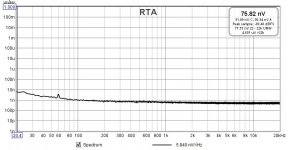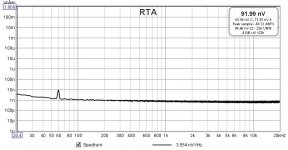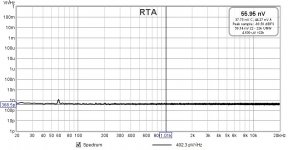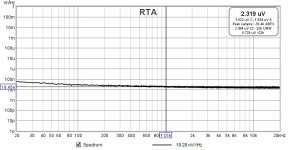Yes I did, you can find the latest published ones here:
https://www.diyaudio.com/community/...grade-any-317-based-v-reg.331491/post-7090788
But I just made some small revisions to them, ordered them and waiting to measure them before I release the new files.
https://www.diyaudio.com/community/...grade-any-317-based-v-reg.331491/post-7090788
But I just made some small revisions to them, ordered them and waiting to measure them before I release the new files.
Yes I think there might be plans for another board, on this thread, and there's also the VRDN which has its own thread.
Elvee, what had been the adjustments you did when you tried other transistors on the Dnoizator?
Absolutely none: the transistor amplifier is ~self-stabilized for DC conditions, and the rest does not depend on the transistor type
The next problem I have been finding is what LM317 or LM337 model to use to provide reliable results, or more shall we say repeatable. And I'm talking about importing the AD Pspice model to LTS, for instance. If you go to the LTSpice community, where they have a library, there's a lot of 3X7 models you can use.
So in the end you have look for a model you can use that gives similar results to the simulations on actual measurements. So which models have proven to do so?
So in the end you have look for a model you can use that gives similar results to the simulations on actual measurements. So which models have proven to do so?
It would be completely different, and I don't see how it could be made to work practically. Anyway, a 317 makes a relatively poor CCS.
None, they all have their specific shortcomings. The true acid-test is the realitySo in the end you have look for a model you can use that gives similar results to the simulations on actual measurements. So which models have proven to do so?
For 400mA or more it's complicated make a stable CCS without LM317.It would be completely different, and I don't see how it could be made to work practically. Anyway, a 317 makes a relatively poor CCS.
Tell me about it! Reality for someone that does not live in the USA or Europe is fake electronic parts! Hard to buy legit ones!None, they all have their specific shortcomings. The true acid-test is the reality
That's why I'm simulating Denoiser options with other transistors that I have here, bought some time ago from Mouser.
In simulations now I returned to the LT317 model that comes with the program, and pray that the transistor models included are good.
Now that I seemed to have got things right, I'm making comparison tables with simulation results at different frequencies, for psrr, noise and impedance. Jung/Didden superregulators with different ICs, LT1963, LT3042, Mosfet discrete, Denoiser (with different transistors), NoNoiser, and some Trilerus designs. I wonder if readers would be interested on these results. I may provide the .asc files where those results were taken from. Publishing the curves might be an option too, but it would be too much perhaps. Let me know if you are interested.
Chinese "second sources" (let's avoid the F.. word) can be quite decent: there is some cost-cutting regarding the quantity and quality of materials (TO220 tabs are thinner for example), but otherwise they tend to behave rather well.
I didn't test the denoiser on cheap 317's from Banggood, but that's something I can do: I have all that is needed to make the test.
IIRC, the LT317 model doesn't include noise, which is a problem in this case.
People are always interested in raw data, comparisons, etc., so feel free to publish them, on this thread or on a dedicated thread of your own.
If there are masses of graphics, it would be a good idea to make them easily accessible, with index(es) for example, to avoid drowning would-be users in an ocean of irrelevant data (for them anyway)
I didn't test the denoiser on cheap 317's from Banggood, but that's something I can do: I have all that is needed to make the test.
IIRC, the LT317 model doesn't include noise, which is a problem in this case.
People are always interested in raw data, comparisons, etc., so feel free to publish them, on this thread or on a dedicated thread of your own.
If there are masses of graphics, it would be a good idea to make them easily accessible, with index(es) for example, to avoid drowning would-be users in an ocean of irrelevant data (for them anyway)
From my measurements I found that TI's LM3x7 spice models are closer to reality than LTSpice's RH117/LT317 (these two share the same model), for AC stuff.
Some preliminary measurements made of the CCS Nonoiser with ZTX x51 transistors installed in the denoiser position. All measurements were taken with 20V battery power.
LM317 Nonoiser with ZTX transistor, 15Vout, 83mA load

LM337 Nonoiser with ZTX trnasistor, 15Vout, 83mA load

LNA + ADC with shorted input

For comparison Super Regulator positive side, 15Vout, 83mA load, AD825 opamp, LM329 voltage reference

LM317 Nonoiser with ZTX transistor, 15Vout, 83mA load

LM337 Nonoiser with ZTX trnasistor, 15Vout, 83mA load

LNA + ADC with shorted input

For comparison Super Regulator positive side, 15Vout, 83mA load, AD825 opamp, LM329 voltage reference

Well, in fact I did just test the same .asc noise file with the LT317 model and another LM317/TI model, and noise is much more higher with the latter, which might be due to the model not including noise. Everything gave very low noise with the LT model.IIRC, the LT317 model doesn't include noise, which is a problem in this case.
Elvee,
Can you upload a properly done D-noizator noise simulation, with .asc file please?
Can you upload a properly done D-noizator noise simulation, with .asc file please?
Last edited:
- Home
- Amplifiers
- Power Supplies
- D-Noizator: a magic active noise canceller to retrofit & upgrade any 317-based VReg